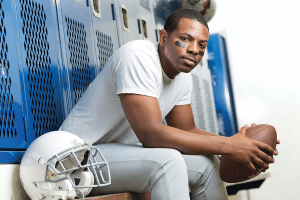Traumatic Brain Injury Prevention
According to the Centers for Disease Control and Prevention, injuries are the leading cause of disability and death in children and adolescents in the U.S. In 2020, Summit County had 18,819 pediatric injuries; with falls and struck by/struck against as the top two causes. Sports and recreation injuries account for 11% of total injuries.
One type of traumatic brain injury (TBI) is a concussion. A TBI is caused by a bump, blow, or jolt to the head or by a hit to the body that causes the head and brain to move rapidly back and forth. The injury can range from mild to severe and can disrupt the way the brain normally works. Brain injury is one of the leading sports-related injuries resulting in the death of children. High school athletes who sustain a concussion are three times more likely to sustain a second concussion.
Kids of all ages are at risk for Traumatic Brain Injuries (TBIs).
TBIs keep kids from being kids – and doing things like going to school, playing in the big game, dancing at a recital – or in the rain. At Akron Children’s, we’re committed to preventing TBIs through education, policy and community engagement, and we’re dedicated to finding the most effective TBI treatments through research and innovation.
TBIs can occur from unintentional falls, sports-related injuries, motor vehicle injuries or pedestrian and wheeled sport injuries. A TBI changes how the brain normally functions. Akron Children’s Unintentional Child/Youth Traumatic Brain Injury Prevention program is implementing strategies to prevent TBI injuries among area kids.
Guided by Safe Kids Summit County, these prevention strategies were developed using child injury data and surveillance to identify trends for those at high risk for injury. They include:
- Promote the Ohio Concussion Return to Learn Team Model program in local schools, which helps prevent concussions by raising awareness of concussion signs and symptoms and providing guidance on how to return to school safely.
- Collaborate with sports organizations and schools to share TBI Return to Play guidelines and resources.
- Adopt bike helmet policies in Summit County schools, and teach community members how to properly fit a bike helmet.
- Expand social marketing campaigns to increase TBI awareness.
For more information contact Sherry Blair: sblair@akronchildrens.org
How can I spot a possible concussion?
Symptoms can worsen with physical and mental activity.
If you suspect a concussion, call 330-543-2778 to make an appointment to have your child evaluated.
Signs observed by others
- Dazed/stunned appearance
- Personality/behavioral changes
- Confusion
- Loss of consciousness-even brief
- Clumsiness
- Forgets plays or assignments
- Seems "out of it"
- Forgets events prior to/after a hit
- Slow response to questions or repeatedly asks questions
Symptoms reported by children and teens
- Headache or "pressure" in head
- Nausea or vomiting
- Balance problems or dizziness
- Double, blurry or changed vision
- Bothered by light or noise
- Excess fatigue/drowsiness
- Changes in sleep patterns
- Trouble comprehending, concentrating or paying attention
- Irritability, nervousness, feeling emotional or sad
- Feeling "just not right" or "in a fog"
When to go to the Emergency Room:
- Loss of consciousness
- Headaches that worsen
- Seizures
- Weakness
- Unequal pupils
- Neck pain
- Confusion
- Repeated vomiting
- Behavior change
How can I help keep my children or teens safe?
Sports are a great way for children and teens to stay healthy and can help them do well in school. To help lower your children’s or teens’ chances of getting a concussion or other serious brain injury, you should:
- Help create a culture of safety for the team by working with the coach to teach ways to lower the chances of getting a concussion.
- When appropriate for the sport or the activity, teach your children or teens that they must wear a properly fitted, safety-approved helmet to lower the chances of the most serious types of brain or head injury. There is no "concussion-proof" helmet, but it may help lessen injury. Even with a helmet, it is important for children and teens to avoid hits to the head.
By using this site, you consent to our use of cookies. To learn more, read our privacy policy.
















